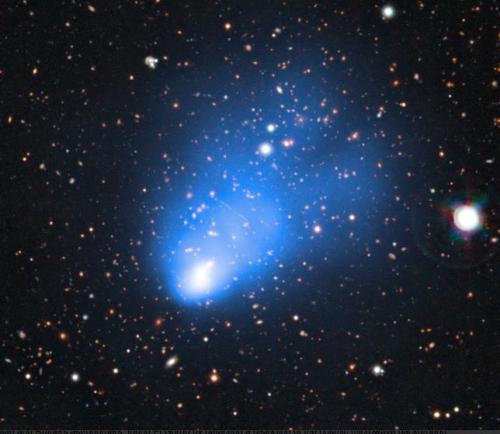
An extremely hot, massive young galaxy cluster -- the largest ever seen in the distant Universe -- has been studied by an international team using ESO's Very Large Telescope in the Atacama Desert in Chile along with NASA's Chandra X-ray Observatory and the Atacama Cosmology Telescope. The new results were announced Jan. 10 at the 219th meeting of the American Astronomical Society in Austin, Texas.
The newly discovered galaxy cluster has been nicknamed El Gordo -- the "big" or "fat one" in Spanish. It consists of two separate galaxy subclusters colliding at several million kilometres per hour, and is so far away that its light has travelled for seven billion years to reach Earth.
"This cluster is the most massive, the hottest, and gives off the most X-rays of any cluster found so far at this distance or beyond," said Felipe Menanteau of Rutgers University, who led the study. "We devoted a lot of our observing time to El Gordo, and I'm glad our bet paid off and we found an amazing cluster collision."
Clusters of galaxies are the largest objects in the Universe held together by gravity. The process of their formation, when smaller groups of galaxies merge together, very much depends on the amount of dark matter and dark energy in the Universe at that time -- so studying clusters can shed some light on these mysterious components of the cosmos.
"Gigantic galaxy clusters like this one are just what we were aiming to find," said team member Jack Hughes, also of Rutgers. "We want to see if we understand how these extreme objects form, using the best models of cosmology that are currently available."
The team, led by Chilean and Rutgers astronomers, found El Gordo by detecting a distortion of the cosmic microwave background radiation. This faint glow is the remnant of the first light from the Big Bang, the extremely hot and dense origin of the Universe about 13.7 billion years ago. This radiation left over from the Big Bang interacts with electrons in the hot gas in galaxy clusters, distorting the appearance of the background glow seen from Earth. The denser and bigger the cluster, the bigger this effect. El Gordo was picked up in a survey of the microwave background with the Atacama Cosmology Telescope.
ESO's Very Large Telescope was used by the team to measure the velocities of the galaxies in this huge cluster collision and also to measure its distance from Earth. In addition NASA's Chandra X-ray Observatory was used to study the hot gas in the cluster.
Although a cluster of El Gordo's size and distance is very rare, the authors say that the new results are still consistent with astronomers' current understanding of a Universe that started with a Big Bang and is mostly made of dark matter and dark energy.
El Gordo most probably formed just like the Bullet Cluster, a spectacular interacting cluster of galaxies that is almost four billion light-years closer to Earth. In both clusters there is evidence that normal matter, mainly composed of hot, X-ray-bright gas, has been wrenched apart from the dark matter. The hot gas was slowed down by the collision, but the dark matter was not.
"This is the first time we've found a system like the Bullet Cluster at such a large distance," said Cristóbal Sifón, student at the Pontificia Universidad Católica de Chile (PUC) in Santiago. "It's like the old saying: If you want to understand where you're going, you have to know where you've been."
<한글기사>
태양 2천兆배의 최대 은하단 발견
태양 질량의 2천조 배나 되는 초거대 은하단이 먼 우주에서 발 견돼 우주를 채우고 있는 암흑물질의 비밀을 밝히는 단서가 되고 있다고 스페이스 닷컴이 10일 보도했다.
미국 러트거스 대학 연구진은 지구로부터 약 70억광년 떨어진 곳에서 발견된 은 하단 ACT-CL J0102-4915의 질량이 우리 태양 2천조(2X10ⁿ: n=15) 개를 합친 것과 같다는 사실을 밝혀냈다고 10일 열린 미천문학회 연례회의에서 발표했다.
이들은 이는 "우주의 나이가 지금의 절반 정도였던 시기의 우주 영역에서 지금 까지 발견된 최대 질량의 은하단"이라고 밝혔다.
`엘 고르도'(El Gordo: 뚱보라는 뜻)라는 별명으로 불리는 이 거대 은하단은 여 러 개의 작은 은하단이 합쳐진 것으로 이런 현상은 암흑물질과 암흑에너지의 양에 따라 양상이 달라진다.
암흑에너지는 우주 전체의 질량과 에너지 가운데 약 73%를 차지하며 우주 팽창 에 가속도를 붙이는 것으로 알려져 있다.
아직 실체가 밝혀지진 않았지만 은하에 미치는 중력 영향 때문에 존재가 간접적 으로 입증된 암흑물질은 우주 에너지와 질량 총량의 약 23%를 차지하며 나머지 4%는 사람을 비롯한 지구상의 모든 물체, 행성, 별 등 천체들이 차지한다.
연구진은 미항공우주국(NASA)의 챈드라 X-선 우주망원경과 칠레 소재 아타카마 우주망원경을 통해 이 은하단을 발견했다. `엘 고르도'란 스페인어 별명은 망원경 소재지인 칠레에 대한 감사의 표시로 지어졌다.
한편 망원경 관측 자료에 따르면 엘 고르도의 가스 온도는 2억℃에 근접해 온도 역시 최고를 기록했다.
연구진은 엘 고르도가 두 개의 분명히 구분되는 집단에 집중돼 있어 두 개의 은 하단이 시속 500만㎞의 속도로 격렬하게 결합중인 현장임을 입증한다고 밝혔다.
이들은 또 엘 고르도와 같은 크기의 은하단이 이 정도 거리에 존재하는 것은 극 도로 희귀하지만 빅뱅 모델의 기준에는 부합하는 것이라고 밝혔다. 이는 우주 대부 분이 암흑물질과 암흑 에너지로 이루어져 있으며 약 137억년 전 빅뱅으로 탄생했음 을 시사하는 것이다. (연합뉴스)




![[Music in drama] Rekindle a love that slipped through your fingers](http://res.heraldm.com/phpwas/restmb_idxmake.php?idx=644&simg=/content/image/2024/05/01/20240501050484_0.jpg&u=20240501151646)

![[New faces of Assembly] Architect behind ‘audacious initiative’ believes in denuclearized North Korea](http://res.heraldm.com/phpwas/restmb_idxmake.php?idx=644&simg=/content/image/2024/05/01/20240501050627_0.jpg&u=20240502093000)




![[KH Explains] Will alternative trading platform shake up Korean stock market?](http://res.heraldm.com/phpwas/restmb_idxmake.php?idx=644&simg=/content/image/2024/05/01/20240501050557_0.jpg&u=20240501161906)






![[Today’s K-pop] Stray Kids go gold in US with ‘Maniac’](http://res.heraldm.com/phpwas/restmb_idxmake.php?idx=642&simg=/content/image/2024/05/02/20240502050771_0.jpg&u=)